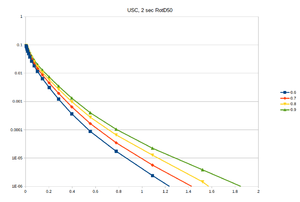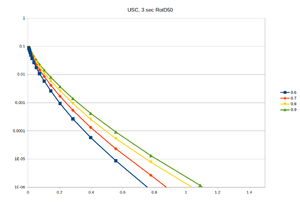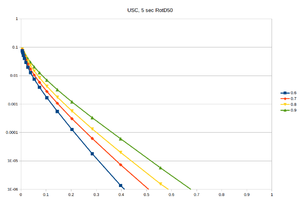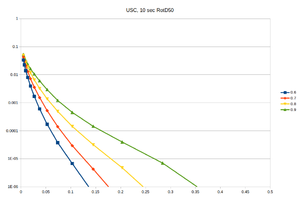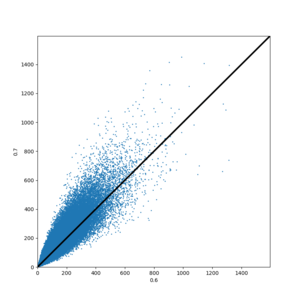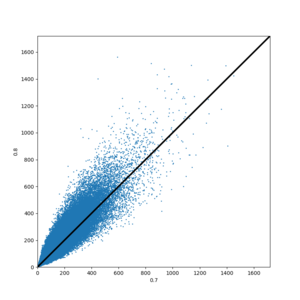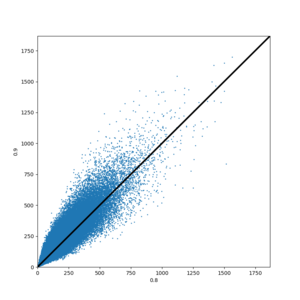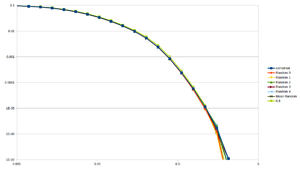Difference between revisions of "CyberShake Study 20.5"
| Line 62: | Line 62: | ||
{| | {| | ||
| − | ! Period !! | + | ! Period !! 2 sec !! 3 sec !! 5 sec !! 10 sec |
|- | |- | ||
| − | ! | + | ! Curve |
| − | + | | [[File:2sec_rvfrac_compare.png|thumb|300px|Comparison of 4 values of rvfrac for site USC, 2 sec RotD50]] | |
| − | |||
| − | |||
| [[File:3sec_rvfrac_compare.png|thumb|300px|Comparison of 4 values of rvfrac for site USC, 3 sec RotD50]] | | [[File:3sec_rvfrac_compare.png|thumb|300px|Comparison of 4 values of rvfrac for site USC, 3 sec RotD50]] | ||
| − | |||
| − | |||
| [[File:5sec_rvfrac_compare.png|thumb|300px|Comparison of 4 values of rvfrac for site USC, 5 sec RotD50]] | | [[File:5sec_rvfrac_compare.png|thumb|300px|Comparison of 4 values of rvfrac for site USC, 5 sec RotD50]] | ||
| − | |||
| − | |||
| [[File:10sec_rvfrac_compare.png|thumb|300px|Comparison of 4 values of rvfrac for site USC, 10 sec RotD50]] | | [[File:10sec_rvfrac_compare.png|thumb|300px|Comparison of 4 values of rvfrac for site USC, 10 sec RotD50]] | ||
|} | |} | ||
Revision as of 15:36, 1 June 2020
CyberShake Study 20.5 is a CyberShake study in Southern California which uses Graves & Pitarka (2019) and includes stochastic high frequencies using the Graves & Pitarka high-frequency module from the SCEC Broadband Platform.
Contents
RotD code verification
We performed a verification exercise with the CyberShake RotD code. Christine selected 40 station recordings from Hector Mine (data here), and we calculated PGA and PGV by passing very small periods to the RotD50 code.
Full results of our Hector Mine tests are available here. Summary results are presented below:
| Metric | Average absolute percent difference (over 40 stations) |
|---|---|
| PGA, using period=1e-3 | 0.0165% |
| PGA, using period=1e-4 | 0.0118% |
| PGA, using period=1e-5 | 0.0118% |
| PGV, using period=1e-3 | 0.532% |
| PGV, using period=1e-4 | 0.526% |
Since most of the Hector Mine recordings have small amplitudes compared to CyberShake (PGA=0.02g to 0.3g), we also performed comparisons for 2 sites from Northridge (PGA=0.5g and 0.8g). The calculated PGA values exactly matched those provided from PEER for the Northridge sites. Input data is available here. Full results are available here.
In conclusion, the differences in the PGA results are small -- about the same as the differences we see when moving between systems -- and get smaller as the ground motions increase, so they are unlikely to have any meaningful impact on CyberShake curves.
Because the PGV results have such a higher difference than the PGA results, we suspected that the PEER-provided velocity seismograms weren't what PEER used to calculate their PGV. We decided to try integrating the acceleration seismograms ourselves and calculating PGV from those.
| Metric | Average absolute percent difference (over 40 stations) |
|---|---|
| PGV, using period=1e-4 and integrating with left rule | 0.1306% |
| PGV, using period=1e-4 and integrating with trapezoid rule | 0.0349% |
| PGV, using period=1e-4, trapezoid rule, and using g = 981 cm/s2 | 0.0% |
This confirms that the RotD code is working correctly, and the issues with PGV agreement are because the PEER PGV values aren't actually calculated from their velocity seismograms.
Based on this work, we will use a period of 1e-4 to obtain CyberShake PGA and PGV using the RotD code.
Conditional Hypocenter Distributions
Based on Kevin's dissertation work showing that non-uniform hypocenter distributions can cause significant differences in OEF forecasts, we investigated the effects of conditional hypocenter distributions (CHD) on overall CyberShake results. Images from this work are available here.
Our conclusion is that, while using a CHD similar to that in Jessica Donovan's thesis can result in changes in long-period hazard up to 20%, we will continue to use a uniform distribution when calculating CyberShake curves. If alternative hypocenter distributions are of interest, the probabilities can always be modified after the fact, but at this point we don't have a clear use case for non-uniform CHD other than general interest.
Rupture velocity (rvfrac)
One of the parameters to the rupture generator is rvfrac, indicating what fraction of shear wave speed the rupture velocity is. In past CyberShake runs, we have used a constant 0.8 value for all ruptures. However, varying rvfrac has a big impact on ground motion. Therefore, we investigated the impact of changing rvfrac.
We calculated hazard curves for USC using rvfrac=0.6, 0.7, 0.8, and 0.9. As expected, this has a significant impact on the hazard curves, and the intensity measure distribution:
| Period | 2 sec | 3 sec | 5 sec | 10 sec |
|---|---|---|---|---|
| Curve |
Here are scatterplots of IM values, showing the impact of successive increases in rvfrac on ground motion.
Additionally, we calculated hazard curves using the combined results from all 4 sets of IMs (so that the probability for each rupture is divided over 4 times as many rupture variations). We compared this to hazard curves created by randomly selected an IM for each rupture variation from the 4 sets of IMs:
File:3sec rvfrac compa.png Comparison of 4 values of rvfrac for site USC, 3 sec RotD50 |
Output Data Products
Seismograms
- Deterministic (dt=0.05, nt=8000)
- Broadband (dt=0.01, nt=40000)
Intensity Measures
Values for database
We will calculate and store the following intensity measures in the database (all PSA values are for 5% damping).
For deterministic seismograms (as simulated):
- Store RotD50, RotD100 at the following 7 periods:
10, 7.5, 5, 4, 3, 2, 1
For broadband seismograms (include minor site effects modifications):
- Store RotD50, RotD100 in the database at the following 21 periods:
10, 7.5, 5, 4, 3, 2, 1, 0.75, 0.5, 0.4, 0.3, 0.2, 0.1, 0.075, 0.05, 0.04, 0.03, 0.02, 0.01, PGA, PGV
Durations
Values for database
We will store the following durations in the database for broadband seismograms:
- Acceleration significant duration based on Arias intensity at 5-75% and 5-95%, for both X and Y
Hazard Curves
We will calculate deterministic hazard curves at the following frequencies:
10, 5, 3, 2 sec
We will calculate broadband hazard curves at the following frequencies:
10, 5, 3, 2, 1, 0.5, 0.3, 0.2, 0.1 sec
